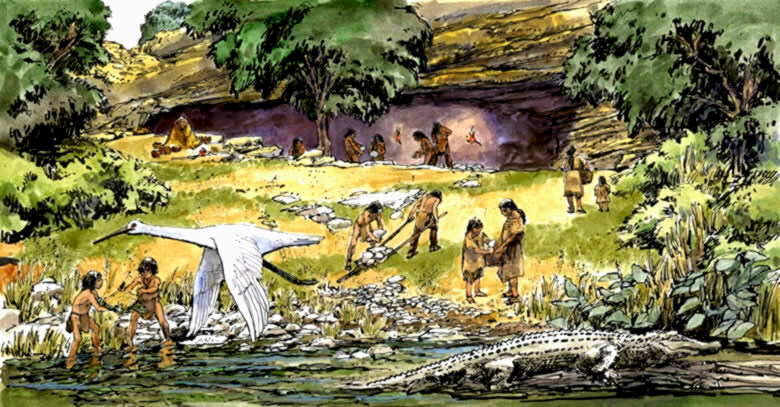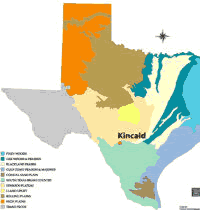
As shown in this map of Texas' natural
regions, Kincaid Shelter is located on the southern
edge of the Edwards Plateau in the scenic Texas Hill
Country. Map adapted from Texas Natural Regions map,
Lyndon B. Johnson School of Public Affairs.
Click images to enlarge
|
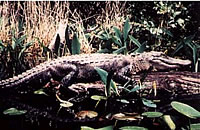
Although not present today, alligators
frequented the riverbanks during the era of Clovis people
in the Texas Hill Country. It was a time when the climate
was cooler and rains fell more frequently than today,
when the Sabinal River flowed year-round, and massive
Pleistocene animals roamed the craggy bluffs and canyons
of the plateau. Photo courtesy U.S. Environmental Protection
Agency.
|
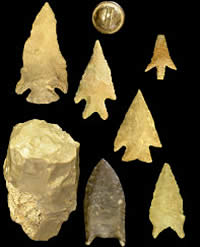
More than 13,000 years of culture
history is represented in these objects from Kincaid
Shelter. The small chert blade core at bottom left was
recognized by archeologist Mike Collins as evidence
that Clovis peoples lived at Kincaid long before Folsom
hunters came on the scene—and that they were almost
certainly the builders of the stone pavement. TARL Collections.
Photo by Aaron Norment.
|
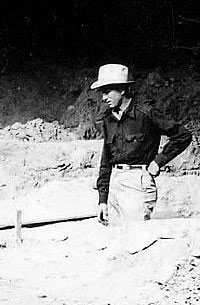
Geologist Glen Evans, shown in one
of the long trenches his crews dug to expose the site's
stratigraphy, or layering. This prudent strategy provided
a "window" to the complex shelter deposits and guided
further excavations. TARL archives. Click to see full
image.
|
|
Kincaid takes our knowledge of Clovis beyond the
oft-repeated myth of nomadic "big-game hunters
following the herds" to a picture of ancient peoples
who selected a place to stay for an extended period,
improved their accommodations, and explored the full
bounty of the area's resources.
|
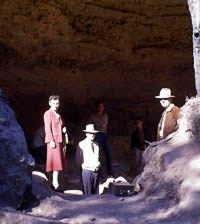
Archeologists and local people alike
had a keen interest in what was being uncovered at the
Kincaid Site. Here, U.T. anthropology professor T. N.
Campbell (center, front) and TMM director E. H. Sellards
(right ) give visitors a tour of the shelter in December,
1948, near the close of the first phase of excavations.
Photo by F. M. Bullard, TARL archives.
|
|
Although we will never know the full details
of its construction, the stone pavement at Kincaid Rockshelter
provides a rare glimpse into the mindset and way of life of
some of North America's earliest peoples. There is no doubt
that improving the shelter required considerable effort and
signified that the people who built it intended to stay for
a while, re-tooling their weapons and staging hunts and other
expeditions from that locale. But who were the builders, and
what was their life like, there on the banks of the Sabinal?
Based on a small array of distinctive tools
and the bones of now-extinct animals deeply buried in the
shelter's deposits, University of Texas archeologist Michael B. Collins believes
these early Hill Country stone masons were Clovis peoples.
If he is correct—and all evidence appears to support
this—the Kincaid stone pavement is the oldest known
structural feature in North America.
Located some 60 miles west of San Antonio, Texas,
Kincaid Shelter is significant as one of a mere handful of
Clovis-period occupation sites—a place where people
lived and invested their labor, unlike more-temporary open
camp sites and animal "kill" sites. As such, Kincaid
helps take our knowledge of Clovis beyond the oft-repeated
stereotype of "nomadic big-game hunters following the
herds" to a picture of ancient peoples who selected a
place to stay for an extended period, improved their accommodations,
and explored the full bounty of the area's resources.
Beyond Clovis, Kincaid Shelter also holds a
long record of later prehistoric peoples. Countless generations
of travelers and campers left behind tantalizing reminders
of their stay along the Sabinal River—Folsom hunters
on the trail of a wounded bison, a succession of Archaic period
peoples, and Late Prehistoric pottery makers and hunters wielding
bows and arrows. In more recent times, a traveler wearing
a Confederate uniform jacket lost a button in front of the
shelter, perhaps en route to battle in New Mexico. Over the
millennia, deep layers of sediment and human debris filled
the shelter and formed a thick terrace deposit outside.
Twentieth-century visitors, however, left a
very different imprint in Kincaid shelter—gaping holes
and mounds of shoveled-out backdirt. Searching for legendary
riches made famous by Texas writers such as J. Frank Dobie,
treasure hunters mined the deeply layered deposits of Kincaid
Shelter and, in the process, nearly destroyed its rich archeological
potential. When a young college student brought the site to
the attention of researchers, the fate of Kincaid Shelter
was changed, however, and its systematic exploration was begun.
Archeological investigations at Kincaid Shelter
were conducted in late 1948 under the direction of Elias H.
Sellards and Glen Evans from the Texas Memorial Museum in
Austin. One of the missions of the Austin museum, like others
across the country at the time, was to find and collect artifacts
of "early man" to fill displays and exhibits. Many
such collecting operations were done haphazardly, with an
eye more for the objects themselves than for understanding
their context.
Fortunately, Evans and Sellards took a more
scientific approach that was to be particularly critical in
verifying the age of the deepest cultural layers. As geologists,
Evans and Sellards were keenly aware of the importance of
depositional processes and stratigraphy. After clearing and
sifting the backdirt, they excavated a deep trench from the
front to the back of the shelter in order to gauge the depth
and character of the shelter fill. This critical process,
unusual by archeological standards of the time, provided a
vertical "window" to view the complex layers of
shelter deposits and guided further excavations.
Five years later, University of Texas anthropology
professor Thomas Nolan Campbell led a field school to investigate
the deep terrace deposits directly in front of the shelter.
Although it later became evident that the deepest layers of
the terrace formed after the critical Late Pleistocene "early
man" levels inside the shelter, the terrace investigation
provided additional information on the Archaic and more-recent
cultures.
In the following sections, readers can learn
more about Kincaid Shelter, from its serendipitous "discovery,"
to systematic excavations by geologists and archeologists,
to trials and errors with trailblazing scientific techniques,
and finally, to the re-analysis of a few stone tools that
solved a decades-long mystery. In the process, readers will
see glimpses of the ancient—and more recent—peoples
who visited and investigated the shelter along the Sabinal.
In the first section, we explore the site in
its Natural Setting in
the scenic Sabinal River valley. In Discovery
and Investigations, we learn of the events that led to
the site's discovery by Charles E. (Gene) Mear, whose career
path in geology was charted at Kincaid, and track the investigations
at the site by the TMM and UT-Austin.
Reading the Layers
interprets the shelter's complex natural stratigraphy, discusses
how the deposits accumulated, and looks at the cultural materials
discovered in the various zones. Examples of the hundreds
of artifacts recovered at Kincaid are presented in Fragments
of the Past. A special gallery, Mysterious
Stones, highlights prehistoric artistry at Kincaid: an
array of pebbles, some engraved with a variety of enigmatic
patterns, others used to make red pigment. All artifacts shown
in the exhibits are curated at the Texas Archeological Research
Laboratory at UT-Austin.
In Kincaid
Revisited: Clovis and Beyond, the story of archeologist
Michael B. Collin's serendipitous involvement with the site
unfolds, and the Paleoindian evidence is examined further.
We also look at Kincaid's significance within the North American
archeological framework.
Learning about Kincaid is a special section
now under development for teachers and students. The first
activity, Kincaid Creatures, challenges students
to identify the various animals—both extinct and modern—
represented at the site and to understand the concept of stratigraphy.
Watch for more activities and lessons to be added.
The Credits
& Sources section provides brief biographical sketches
of the Kincaid researchers and references and links for learning
more about various topics in the Kincaid exhibits.
|
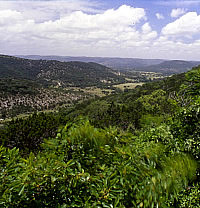
Rolling, tree-covered hills and narrow
valleys cut by crystalline streams are hallmarks of
the Texas Hill Country. Prehistoric hunters and gatherers
were attracted to the rich resources—water, game,
and fuel, just as travelers are today. Photo courtesy
Texas Parks and Wildlife Department.
|
|
Like postcards from the past, the
fragments of ancient tools, weapons,
bones, and stones have a story to tell.
But, deplorably, the rich archeological
potential of Kincaid Shelter was plundered,
its deep layers of evidence nearly destroyed
by treasure hunters who left gaping
pits and piles of backdirt in their
wake.
|
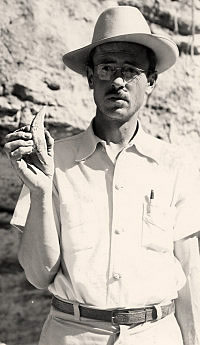
Paleontologist Grayson Meade holds
the massive canine of a cave lion, one of many now-extinct
species that prowled the Edwards Plateau during the
Late Pleistocene. The tooth and a variety of other fossil
bones were recovered in the deeper layers of the shelter
that pre-date human use. TARL archives.
|
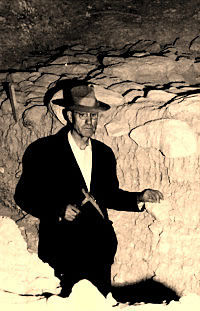
Posed in a trench below the early
rock pavement, Texas Memorial Museum Director E. H.
Sellards, a geologist and paleontologist by training,
examines the deposits under the feature. TARL archives.
|
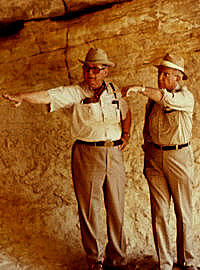
Returning to Kincaid after more than
40 years, geologists Glen Evans and Gene Mear recall
details of excavations at the site. It was Mear who
brought the site to the attention of researchers at
the Texas Memorial Museum in 1948, after finding several
rare Folsom points. Photo by Tom Hester, TARL archives.
|
|
